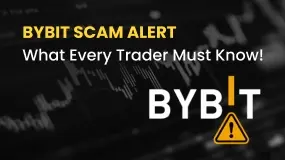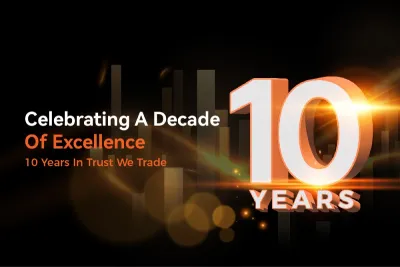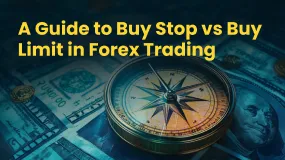简体中文
繁體中文
English
Pусский
日本語
ภาษาไทย
Tiếng Việt
Bahasa Indonesia
Español
हिन्दी
Filippiiniläinen
Français
Deutsch
Português
Türkçe
한국어
العربية
Forex Interbank Rate & How It Influences Your Trading
Abstract:A forex interbank rate is nothing but the wholesale currency exchange rate that banks and other major financial institutions use to trade currencies among themselves. Read more about it.

The forex market sees participation from banks and several retail and corporate traders. What strikes everyone is the interbank rate. Avid traders know the intricacies presented by the forex interbank rate. But someone eyeing to make a mark in the forex market may want to know about this rate and how it impacts their trading.
What is the Forex Interbank Rate?
The interbank rate is nothing but the wholesale currency exchange rate that banks and other major financial institutions use to trade currencies among themselves. These trading transactions take place on the interbank market that connects financial institutions globally through a decentralized, over-the-counter network. Banks initiate trading for several reasons, including international trade enablement, foreign exchange currency reserve management, or to hedge against currency risks. The forex interbank rate, which demonstrates live market conditions, is decided based on the demand-supply dynamics.
Key Forex Interbank Rate Features
Real-time Pricing
The constant fluctuation in the interbank rate is attributable to the varying market conditions such as geopolitical scenarios, the central bank-driven monetary policy, and economic data releases by both developed and emerging economies. Depending on how things fare across these parameters, the real-time pricing varies.
Large Volume Transactions
Banks usually make large volume trading, leading to extremely competitive rates and tight spreads.
Limited Access
Only major financial institutions can access forex interbank rates, as retail traders and small business enterprises make use of marked-up rates offered by banks or brokers.
What Influences the Forex Interbank Rate?
There are multiple factors contributing to the interbank rate. These include economic indicators, monetary policies adopted by central banks, market sentiments, geopolitical events, and supply-demand dynamics.
Economic Indicators and How They Impact Interbank Rates
Economic indicators such as GDP growth, inflation, and interest rates greatly impact the forex interbank rate. A strong Gross Domestic Product (GDP) growth showcases a healthy economy, increasing demand for the currency and the forex interbank rate. At the same time, high inflation lessens the currency‘s purchasing power. As a result, the investor’s interest in the currency drops, resulting in lower interbank rates. Higher interest rates lead to capital flows from foreign investors. The demand for the currency goes up. Consequently, that reflects in higher forex interbank rates.
Central Banks‘ Monetary Policy
The monetary policy adopted by central banks across regions dictates forex interbank rates. Central banks adjust interest rates, prepare a guide for inflation trends, and manage foreign exchange reserves, impacting a currency’s value with respect to others. The impact on the currencys value influences the forex interbank rate.
As the central bank raises interest rates, it leads to high foreign investments. The currency demand props up as a result. It changes the interbank rate as other banks change their lending rates to showcase the fresh market conditions. However, if the interest rates are decreased, foreign investors might move away, causing currency depreciation. Accordingly, there will be a change in the forex interbank rate.
Central banks all over look to keep prices stable so that the economy remains robust. Controlling inflation boosts investor confidence and can raise the currency value and change the interbank rate. Moreover, actions and communication regarding inflation control can dictate market expectations. If the central bank indicates that it will take action to curb inflation, the currencys value will increase, reflected in the forex interbank rate.
Market Sentiment
Currency prices can fluctuate owing to what investors perceive in terms of economic movement. In the case of positive sentiment, the currency value will appreciate, and that will be shown positively in the interbank rate.
Geopolitical Scenario
For the last three years, this term ‘Geopolitical’ has gained mainstream focus in the advent of multiple wars. Be it the Russia-Ukraine War of 2022 and the recent conflict between Israel and Iran, global markets, including foreign exchange rates, have seen dramatic changes because of these uncertain events. They affected currency values and interbank rates.
Demand-Supply Dynamics
The demand-supply chain involving currency buyers and sellers affects the interbank rate at any time.
The Impact of Interbank Rate on Forex Pricing
The interbank rate impacts the forex pricing. Retail customers dont receive the interbank rate. Banks, currency exchange providers, and brokers place a markup to cover operational expenses and enjoy profit margins. The markup so offered is the gap between the interbank rate and the currency exchange rate offered to businesses and individuals.
Spread
It showcases the difference between the ask price (selling price) and bid price (buying price) of a currency pair. At the interbank level, minimal spreads are applied owing to high transaction volumes and enhanced liquidity. Retail traders and consumers, however, will have to deal with wider spreads, especially for currency pairs with reduced liquidity.
Markup Costs
Currency exchange providers and banks apply a margin to the interbank rate to cover expenses and maintain profitability. The markup costs can change depending on the currency pair and the provider.
Transaction Volume
Large transactions offer better currency exchange rates owing to economies of scale. As banks transact in large volumes, the interbank forex rate remains good.
To catch the latest on forex, download our WikiFX App today

Also, join our community - WikiFX India - on Telegram today.

Disclaimer:
The views in this article only represent the author's personal views, and do not constitute investment advice on this platform. This platform does not guarantee the accuracy, completeness and timeliness of the information in the article, and will not be liable for any loss caused by the use of or reliance on the information in the article.
Read more

Bybit Scam Alert: What Every Trader Must Know!
The cryptocurrency trend is still growing and isn’t going away. More people are investing every day, hoping to profit from this fast-moving market. But opportunity comes with risk. If you want to start trading, make sure you choose a broker that is safe, licensed, and transparent. Remember, if you fall for the Scam brokers like Bybit, they could steal your money. Learn why Bybit is not a safe choice before you invest.

WeTrade Marks 10th Anniversary with Global Campaign, Upgrades and Rewards
The leading financial broker celebrates a decade of excellence with worldwide screen takeovers viewed by millions

A Guide to Buy Stop vs Buy Limit in Forex Trading
Want to make a mark in forex trading by seizing hidden growth opportunities or preventing capital loss? Learn the art of locating orders. With an in-depth understanding of order functionality involving the impact on trades, traders can successfully navigate the forex market. As far as buying is concerned, traders need to acquaint themselves with a buy limit and a buy stop. These two orders play a critical role in helping traders enter and exit the market efficiently.

Investment Scam Alert: FCA Identifies 15 Scam Brokers
UK Financial regulator, FCA (Financial Conduct Authority) has issued warnings against 15 forex brokers operating without proper authorization. Checkout the list below & Be Scam ALERT .
WikiFX Broker
Latest News
D. Boral Capital agrees to a fine as a settlement with FINRA
Beware of Fake RS Finance: How to Spot Scams
Fortune Wave Solution: SEC Warns of Investment Scam
XS.com Broker Partnership Expands Liquidity with Centroid Integration
FCA Publishes New Warning List! Check It Now to Stay Safe
EC Markets: A Closer Look at Its Licenses
Housewife Scammed of RM68,242 in Online Investment Scam
From Charts to Profits: Unleashing the Power of Forex Trading Tools
Is TD Ameritrade Safe? How to Spot Fake URLs and Stay Protected
Engineer Loses RM230,000 in “Elite Group” Investment Scam
Currency Calculator


